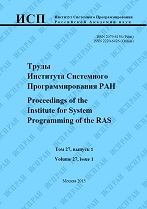|
This article is cited in 1 scientific paper (total in 1 paper)
Error detection in binary code with dynamic symbolic execution
A. V. Vishnyakova, E. A. Kobrinba, A. N. Fedotova
a Institute for System Programming, Russian Academy of Sciences
b Lomonosov Moscow State University
Abstract:
Modern software is rapidly developing, revealing new program errors. More and more companies follow security development lifecycle (SDL). Fuzzing and symbolic execution are among the most popular options for supporting SDL. They allow to automatically test programs and find errors. Hybrid fuzzing is one of the most effective ways to test programs, which combines these two techniques. Checking security predicates during symbolic execution is an advanced technique, which focuses on solving extra constraints for input data to find an error and generate an input file to reproduce it. In this paper we propose a method for automatically detecting errors with the help of dynamic symbolic execution, combining hybrid fuzzing and checking security predicates. Firstly, we run hybrid fuzzing, which is required to increase number of corpora seeds. Then we minimize corpora. Thus, it would give the same coverage as the original corpora. After that we check security predicates on minimized corpora. Thus, security predicates allow to find errors like division by zero, out of bounds access, integer overflow, and more. Security predicates results are later verified with sanitizers to filter false positive results. As a result of applying the proposed method to different open source programs, we found 11 new different errors in 5 projects.
Keywords:
dynamic symbolic execution, DSE, fuzzing, security predicate, automatic error detection, security development lifecycle, SDL, binary code, sanitizer, bug, error, CWE
Citation:
A. V. Vishnyakov, E. A. Kobrin, A. N. Fedotov, “Error detection in binary code with dynamic symbolic execution”, Proceedings of ISP RAS, 34:2 (2022), 25–42
Linking options:
https://www.mathnet.ru/eng/tisp675 https://www.mathnet.ru/eng/tisp/v34/i2/p25
|

| Statistics & downloads: |
| Abstract page: | 27 | | Full-text PDF : | 15 |
|




 Contact us:
Contact us: Terms of Use
Terms of Use
 Registration to the website
Registration to the website Logotypes
Logotypes








 Citation in format
Citation in format 
